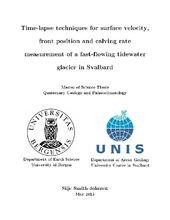Time-lapse techniques for surface velocity, front position and calving rate measurement of a fast-flowing tidewater glacier in Svalbard
Master thesis
Permanent lenke
https://hdl.handle.net/1956/10422Utgivelsesdato
2015-05-31Metadata
Vis full innførselSamlinger
- Department of Earth Science [1034]
Sammendrag
Calving is the mechanical loss of icebergs from tidewater glaciers, responsible for 70% of the annual transfer of mass from the cryosphere to the ocean (van der Veen 1998a, 2002). To be able to correctly predict future global sea level changes it is important to understand calving processes and incorporate them into the models. The aim of this thesis is to investigate surface velocities, front positions and calving rates of a fast flowing tidewater glacier in Svalbard using an automatic oblique terrestrial time-lapse camera. The camera took pictures every 30 min from May 1st to September 16th 2014 resulting in 6600 images. The project forms part of the ConocoPhillips-Lundin Northern Area Program project CRIOS (Calving Rates and Impact on Sea Level) program whose overall aim is to develop better calving-process models. Mean velocities of Kronebreen increased from 3 m/day in May and reached a peak in mid-July of 5.3 m/day, with a velocity pattern showing increasing velocities towards the front and the centreline. Velocity results were filtered, sensitivity tested, averaged both spatially and temporally and fit well with previous results. Results suggest that velocity has a forcing from air temperature and rain events due to water inputs in the glacier system. Mean front positions showed a total retreat of 320 m, and calving rates reached a peak in early August of 11 m/day. Different parts of the front showed different styles of retreat, and therefore calving styles. Inter-meltwater-plume areas were dominated by infrequent large calving events, and plume areas were dominated by continuous calving. Mean calving rates may be atmospherically controlled, but internal dynamics, melt-water plumes and fjord temperatures may also play a role. The high resolution both spatially and temporally gained using this method makes it possible to investigate the nature of calving and the evolution of surface velocity patterns in more detail than satellite derived results. These data are required for improving the understanding of calving dynamics to develop sea level rise models.
